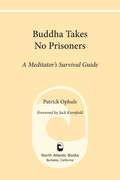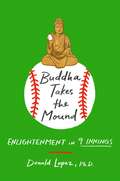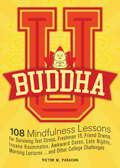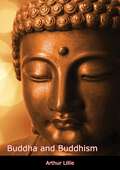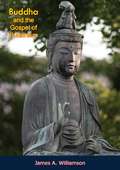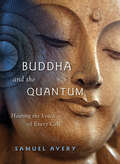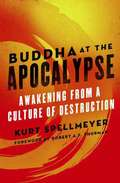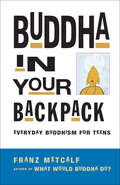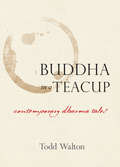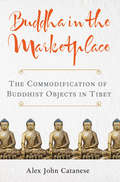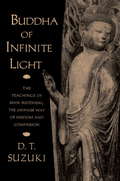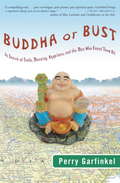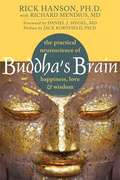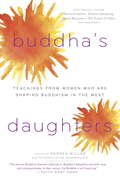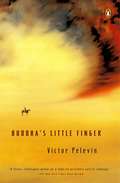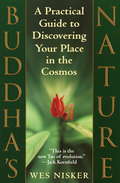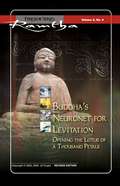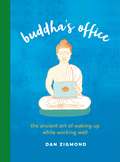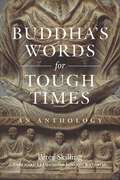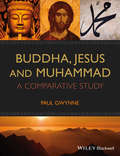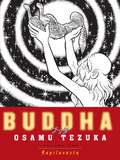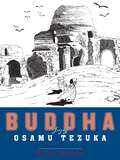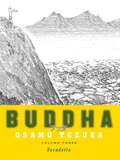- Table View
- List View
Buddha Takes No Prisoners
by Jack Kornfield Patrick OphulsThis insightful, easy-to-read handbook offers a non-traditional perspective on meditation. Written primarily for American insight meditation students, it delivers the Buddha's essential teachings clearly, straightforwardly, and without spiritual jargon, and helps make sense of practices often laden with traditional terminology. Practical explanations of the meditation process, its benefits and applicability to daily life, and warmly humorous advice and encouragement give new practitioners the help necessary to continue practicing meditation on a regular basis.
Buddha Takes the Mound: Enlightenment in 9 Innings
by Donald S. Lopez Jr.In 2010 a Buddhist scroll was found in the ruins of Yankee stadium, and it proved what Buddhist scholar/award-winning author Donald Lopez, Ph.D., had suspected: the Buddha created the game of baseball.Buddha Takes the Mound: Enlightenment in 9 Innings is The Tao of Pooh for baseball. Funny, moving, and enlightening, this is a read that will engross, enrich, and charm any baseball fan. At once a love letter to the sport and an engaging introduction to Buddhism, it shows how the Buddha invented baseball to teach us deep truths about the world, about ourselves, and about each other. Lopez believes that Buddhism provides a lens for us to see baseball in a new way, a way that makes us love the game even more, a way that makes us ponder profound questions about winning and losing, about who we are, about finitude and infinitude, about birth and death. As Lopez reveals, not only is Buddhism integral to baseball; but baseball is Buddhism, and baseball is ourselves.
Buddha U: 108 Mindfulness Lessons for Surviving Test Stress, Freshman 15, Friend Drama, Insane Roommates, Awkward Dates, Late Nights, Morning Lectures...and Other College Challenges
by Victor M. ParachinA GO-TO GUIDE FOR CONQUERING THE OBSTACLES OF MODERN COLLEGE LIFE USING TIMELESS BUDDHIST PRINCIPLESWhat&’s the secret to surviving college? Staying calm and focused—what a Buddhist would call mindfulness. Whether you feel lost, overwhelmed or depressed, Buddha U teaches the healthy perspective that will keep you on the path to a great college experience.Divided into 108 straightforward lessons that approach life day by day, Buddhist principle by principle, this book will transform your college life into a well-managed, stress-free experience. As you put them into practice, you will find yourself ending one academic year with immense satisfaction and anticipating the new one with great enthusiasm.
Buddha and Buddhism
by Arthur LillieEmbark on an enlightening exploration of one of the world’s most profound spiritual traditions with Arthur Lillie's Buddha and Buddhism. This comprehensive study offers a detailed examination of the life of Siddhartha Gautama, known as the Buddha, and the development and principles of the religion he founded, which has inspired millions for over two millennia.Arthur Lillie, a respected scholar and historian, provides a meticulous account of the historical and cultural context in which Buddhism emerged. Buddha and Buddhism delves into the early life of the Buddha, his quest for enlightenment, and the pivotal moments that shaped his teachings. Lillie’s narrative captures the essence of the Buddha’s journey from prince to enlightened sage, illuminating the core experiences that led to his profound insights into the nature of existence.The book offers an in-depth exploration of the fundamental teachings of Buddhism, including the Four Noble Truths, the Noble Eightfold Path, the concepts of karma and rebirth, and the practice of meditation and mindfulness. Lillie’s scholarly approach provides clarity and depth, making complex philosophical concepts accessible to readers of all backgrounds. Lillie highlights the key figures, texts, and schools of thought that have shaped Buddhist tradition, offering a comprehensive overview of its rich and diverse history.Buddha and Buddhism is an essential resource for anyone seeking to understand the origins and evolution of Buddhism, its core principles, and its enduring impact on global spirituality and culture. Arthur Lillie’s insightful and thorough analysis provides readers with a deeper appreciation of the profound wisdom and compassion at the heart of the Buddha’s teachings.Join Arthur Lillie on a journey through the life of the Buddha and the development of Buddhism, and discover the timeless truths that continue to inspire and guide countless individuals on their spiritual paths.
Buddha and the Gospel of Buddhism
by Ananda Coomaraswamy“THE aim of this book is to set forth as simply as possible the Gospel of Buddhism according to the Buddhist scriptures, and to consider the Buddhist systems in relation, on the one hand, to the Brahmanical systems in which they originate, and, on the other hand, to those systems of Christian mysticism which afford the nearest analogies. At the same time the endeavour has been made to illustrate the part which Buddhist thought has played in the whole development of Asiatic culture, and to suggest a part of the significance it may still possess for modern thinkers.“The way of the Buddha is not, indeed, concerned directly with the order of the world, for it calls on higher men to leave the marketplace. But the order of the world can only be established on a foundation of knowledge: every evil is ultimately traceable to ignorance. It is necessary, then, to recognize the world for what it truly is. Gautama teaches us that the marks of this life are imperfection, transcience, and the absence of any changeless individuality. He sets before us a summum bonum closely akin to the Christian mystic conception of ‘self-naughting.’ Here are definite statements which must be either true or false, and a clearly defined goal which we must either accept or refuse. If the statements be false, and if the goal be worthless, it is of the highest importance that the former should be refuted and the latter discredited. But if the diagnosis be correct and the aim worthy, it is at least of equal importance that this should be generally recognized: for we cannot wish to perpetuate as the basis of our sociology a view of life that is demonstrably false or a purpose demonstrably contrary to our conception of the good.“This book is designed, therefore, not as an addition to our already overburdened libraries of information, but as a definite contribution to the philosophy of life.”—Ananada K. Coomaraswamy
Buddha and the Quantum: Hearing the Voice of Every Cell
by Samuel AveryBuddha and the Quantum is about the connection between meditation and physics. Many books show parallels between consciousness and physics; a few of these attempt to explain consciousness in terms of the physics of everyday experience.
Buddha and the Rose
by Mallika ChopraA Junior Library Guild selection! A gorgeously illustrated picture book about the myth of the Buddha and a simple rose told by wellness and mindfulness expert Mallika Chopra. Buddha sat, gazing at the flower in his hand, a smile on his face. Sujata, the milkmaid, approached Buddha with some rice puddling to break his long fast. As she gazed at the Buddha and then at the rose, she closed her eyes, took a deep breath, opened her eyes, and what she saw and felt changed her life forever. A subtle, powerful, and calming story about our connection with the natural world and the universe that connects all of us. Wellness expert and author Mallika Chopra and illustrator Neha Rawat breathe life into this simple but poignant story of awareness, wonder, and the joy of being present and open to seeing the world in new ways.
Buddha at the Apocalypse
by Kurt Spellmeyer Robert ThurmanTimely and audacious, Buddha at the Apocalypse challenges us to look directly at the devastating assumptions underlying the very mechanisms of the modern world - and offers a clarion call to awaken from a pervasive culture of destruction into a natural, sustainable, and sane peace. Kurt Spellmeyer references the Bible, popular culture, Zen, and Western philosophy in addressing two questions: how did we get here, and what can we do now. An answer to pervasive cynicism and decline, Buddha at the Apocalypse shows how to accept and connect with reality in dark times.
Buddha in Your Backpack: Everyday Buddhism for Teens
by Franz MetcalfA guide for navigating the teen years, Buddha in Your Backpack is for young people who want to learn more about Buddhism or for those who simply want to understand what's going on inside themselves and in the world around them. Buddha in Your Backpack tells Buddha's life story in a fashion teens will relate to, describing Buddha as a young rebel not satisfied with the answers of his elders. It then introduces Buddha's core teachings with chapters like "All About Me" and "Been There, Why'd I Do That?" The author presents thoughtful and spiritual insights on school, dating, hanging out, jobs, and other issues of special interest to teens - inviting readers to look inside themselves for answers.
Buddha in a Teacup: Contemporary Dharma Tales
by Todd WaltonThe forty-two short tales that comprise Buddha In A Teacup are set in contemporary America, as opposed to long ago China or India. Each parable springs from the author's meditations on fundamental aspects of Buddhist dharma as those teaching apply to the world today. Some of the tales are humorous, some sad, some erotic, some mysterious-all linked and balanced by themes of mindfulness, compassion, generosity, kindness and love. The reader need not be a Buddhist or know anything about Buddhism to fully appreciate and enjoy these universal tales of the human condition.
Buddha in the Marketplace: The Commodification of Buddhist Objects in Tibet (Traditions and Transformations in Tibetan Buddhism)
by Alex John CataneseClassical Tibetan Buddhist scriptures forbid the selling of Buddhist objects, and yet there is today a thriving market for Buddhist statues, paintings, and texts. In Buddha in the Marketplace, Alex John Catanese investigates this practice, which continues to be viewed as a form of "wrong livelihood" by modern Tibetan Buddhist scholars. Drawing on textual and historical sources, as well as ethnographic research conducted in the region of Amdo, Tibet, Catanese follows the trajectory of Buddhist objects from their status as noncommodities prior to the Cultural Revolution to their emergence as commodities on the open market in the modern period. The book examines why Tibetans have more recently begun to sell such objects for their personal livelihoods when their religious tradition condemns such business activities in the strongest possible terms. Addressing the various societal and religious ramifications of these commercial practices, Catanese illustrates how such activity is leading to significant cultural and economic changes, transforming the "moral economy" associated with Buddhist objects, and contributing to a reinterpretation of Tibetan Buddhist identity.
Buddha of Infinite Light: The Teachings of Shin Buddhism, the Japanese Way of Wisdom and Compassion
by Daisetz T. SuzukiShin is the uniquely Japanese flowering of the type of Buddhism known as "Pure Land." It originated in the thirteenth century with the charismatic and prophetic figure Shinran (1172-1263), whose interpretation of the traditional Pure Land teachings was extremely influential in his own lifetime and remain so today. In a period when Japanese Buddhism was dominated by an elitist monastic establishment, Shinran's Shin teaching became a way of liberation for all people, regardless of age, class, or gender. Although Shin is one of Japan's greatest religious contributions--and is still the most widely practiced form of Buddhism in Japan--it remains little known in the West. In this book, based on several lectures he gave in the 1950s, D. T. Suzuki illuminates the deep meaning of Shin and its rich archetypal imagery, providing a scholarly and affectionate introduction to this sometimes misunderstood tradition of Buddhist practice.
Buddha or Bust
by Perry GarfinkelWhy does an idea that's 2,500 years old seem more relevant today than ever before? How can the Buddha's teachings help us solve many of the world's problems? Journalist Perry Garfinkel circumnavigated the globe to discover the heart of Buddhism and the reasons for its growing popularity--and ended up discovering himself in the process.The assignment from National Geographic couldn't have come at a better time for Garfinkel. Burned out, laid up with back problems, disillusioned by relationships and religion itself, he was still hoping for that big journalistic break--and the answers to life's biggest riddles as well. So he set out on a geographic, historical and personal expedition that would lead him around the world in search of those answers, and then some.First, to better understand the man who was born Prince Siddhartha Gautama, he followed the time-honored pilgrimage "in the footsteps of the Buddha" in India. From there, he tracked the historical course of Buddhism: to Sri Lanka, Thailand, China, Tibet, Japan and on to San Francisco and Europe. He found that the Buddha's teachings have spawned a worldwide movement of "engaged Buddhism," the application of Buddhist principles to resolve social, environmental, health, political and other contemporary problems. From East to West and back to the East again, this movement has caused a Buddhism Boom. Along the way he met a diverse array of Buddhist practitioners--Thai artists, Indian nuns, Sri Lankan school children, Zen archers in Japan, kung fu monks in China and the world's first Buddhist comic (only in America). Among dozens of Buddhist scholars and leaders, Garfinkel interviewed His Holiness the Dalai Lama, an experience that left him speechless--almost. As just reward for his efforts, toward the end of his journey Garfinkel fell in love in the south of France at the retreat center of a leader of the engaged movement, the Vietnamese Buddhist monk Thich Nhat Hanh--a romance that taught him as much about Buddhism as all the masters combined. In this original, entertaining book, Garfinkel separates Buddhist fact from fiction, sharing his humorous insights and keen perceptions about everything from spiritual tourism to Asian traffic jams to the endless road to enlightenment.From the Hardcover edition.
Buddha's Brain: The Practical Neuroscience of Happiness, Love, and Wisdom
by Rick Hanson Richard MendiusJesus, Moses, Mohammed, Gandhi, and the Buddha all had brains built essentially like anyone else's, yet they were able to harness their thoughts and shape their patterns of thinking in ways that changed history. With new breakthroughs in modern neuroscience and the wisdom of thousands of years of contemplative practice, it is possible for us to shape our own thoughts in a similar way for greater happiness, love, compassion, and wisdom. Buddha's Brain joins the forces of modern neuroscience with ancient contemplative teachings to show readers how they can work toward greater emotional well-being, healthier relationships, more effective actions, and deepened religious and spiritual understanding. This book will explain how the core elements of both psychological well-being and religious or spiritual life-virtue, mindfulness, and wisdom--are based in the core functions of the brain: regulating, learning, and valuing. Readers will also learn practical ways to apply this information, as the book offers many exercises they can do to tap the unused potential of the brain and rewire it over time for greater peace and well-being.
Buddha's Daughters
by Andrea MillerCompelling and informative teachings by the most influential female Buddhist teachers on a wide range of topics. Buddhism began to take root in the West at just the same time that women's voices were arising to find expression here--after millennia of being relegated to the background. If that was a coincidence, it was an auspicious one, for the women who emerged as Buddhist teachers have been among the most articulate of Dharma-communicators--and they remain an indelible feature of Western Buddhism as the practice matures here. The remarkable range of their teaching is showcased in this anthology. The pieces featured touch on the topics that are at the heart of our lives--relationships, uncertainty, love, parenting, food, stress, mortality, living fully, and social responsibility. These approachable, engaging teachings illuminate Buddhist concepts and practices, such as meditation, tonglen, lovingkindness, cultivating gratitude, and deep relaxation. The book contains wisdom from such well-known and respected contemporary Buddhist teachers as Pema Chödrön, Ayya Khema, Sharon Salzberg, Toni Packer, Maurine Stuart, Karen Maezen Miller, Khandro Rinpoche, Jan Chozen Bays, Sister Chan Khong, Sylvia Boorstein, Pat Enkyo O'Hara, Darlene Cohen, Joanna Macy, Bonnie Myotai Treace, Tsultrim Allione, Tenzin Palmo, Tara Brach, Joan Sutherland, Carolyn Rose Gimian, Joan Halifax, and Charlotte Joko Beck.
Buddha's Little Finger
by Victor PelevinThe Russian author Victor Pelevin is rapidly establishing a reputation as one of the most brilliant young writers at work today. His comic inventiveness and talent as a pure fabulist have won him comparisons to Kafka, Calvino, Bulgakov, Gogol, Phillip K. Dick, and Joseph Heller, and Time magazine has described him as a "psychedelic Nabokov for the cyberage. " In Pelevin's new novel, Buddha's Little Finger, Pyotr Void, a leading St. Petersburg poet, unexpectedly finds himself in the midst of the 1919 civil war in Russia, serving as commissar to the legendary Bolshevik commander Vasily Ivanovich Chapaev and his formidable machine-gunner sidekick, Anna. But what is the secret of her machine gun? Why does Pyotr keep waking to find himself in a psychiatric hospital in Moscow in the 1990s? And where does Arnold Schwarzenegger fit into all this? Shifting between time and place and spinning story upon story, Buddha's Little Finger is unlike any other novel, a work of demonic absurdism that demonstrates Pelevin's genius for metaphysical comedy.
Buddha's Nature
by Wes NiskerThe Buddha said that "everything we need to know about life can be found inside this fathom-long body." Then why is most people's spirituality--whether Buddhist, Christian, or Jewish--completely cut off from their body? In this provocative and groundbreaking book, you'll discover that enlightenment comes not from "out there," but from a deep understanding of our own personal biology. Using the Four Foundations of Mindfulness, a traditional Buddhist meditation, Nisker shows how cutting-edge science is proving the tenets first offered by the Buddha.And he provides a practical program, complete with meditations and exercises, that enables readers to become mindful of the origins of emotions, desires, and thoughts. One of the great synthesizers of East and West, Nisker shows how to incorporate the traditional understanding of the Buddha with the latest scientific discoveries while on our spiritual journey. He shows that we are not separate from nature and the evolving universe. The way to enlightenment lies within our very biology.Most important, Nisker offers a practical program--complete with meditations and exercises--so readers can take their own evolutionary journey into their bodies to find the origins of emotions, desires, and thoughts. Nisker provides a liberating way for each of us to incorporate into our lives the understanding, proven by the latest scientific evidence and foretold in the great traditional teachings of the Buddha, that we are not separate from nature and the evolving universe. Our biology is not our destiny, but our way to enlightenment.
Buddha's Neuronet for Levitation: Opening the Lotus of a Thousand Petals (Fireside (New Leaf/JZK))
by Ramtha"If we have just discussed the viable science of levitation - in which that you as a heavy, three-dimensional object vibrating according to the hertz of the planet allows you to have the same stability as mass itself - if suddenly you were to change your field, then the mass that you are made up of would change as well. So it would vibrate; you would still be you but you would be vibrating at another frequency. In other words, we can see you and you are still John Doe, but you are not in the world because you are no longer obeying the laws of gravity and physics here. So you are actually levitating fifteen feet above the floor; we can see you, but you are eating the surrounding time in this time. And while you are sitting there, you are actually in the future. You are in another dimension of time that will one day be your linear future." - Ramtha
Buddha's Office: The Ancient Art of Waking Up While Working Well
by Dan ZigmondCan enlightenment be found at the office? From the co-author of Buddha's Diet comes another book that shows how the wisdom of Buddha can apply to our modern lives -- this time exploring how Buddha's guidance can help us navigate the perils of work life. Without setting foot in an office, Buddha knew that helping people work right was essential to helping them find their path to awakening. Now more than ever, we need Buddha's guidance. Too many of us are working long hours, dealing with difficult bosses, high-maintenance coworkers, and non-stop stress. We need someone to help remind us that there is a better way. With Buddha's wisdom at the core of every chapter, Buddha's Office will help you learn how to stop taking shortcuts and pay more attention, care for yourself and others, deal with distractions, and incorporate Buddha's ageless instructions into our modern working life.It's time to wake up and start working in a more enlightened way. One that is right for you, right for our health, right for your sanity, and right for the world.
Buddha's Words for Tough Times: An Anthology
by Peter SkillingTwenty translations from the vast corpus of Buddhist literature come alive in this full-color anthology of ancient wisdom for turbulent times, as a master scholar uncovers their sources and significance.Change and loss have always been part of the human condition, but in today&’s world, the pace and intensity of uncertainty has reached new extremes. The Buddha observed the truth of impermanence more than 2,500 years ago and diagnosed the source of the anxiety it engenders so incisively that his prescription still resonates and heals here and now. In Buddha&’s Words for Tough Times, Peter Skilling, one of the world&’s foremost authorities on Buddhist scripture, brings the reader face to face with the wealth of Buddhist literature, from a teaching in a single word, to a seminal collection of verses on impermanence, to narrations of the Buddha&’s teaching journeys across the Gangetic Plain. Translating from sources in Tibetan, Sanskrit, and Pali, he uncovers the complex history of the vast writings of the Buddhist canons, and his skill in revealing the meaning of twenty gems from within those riches brings them alive for English readers. We could have no better guide for this exploration, an exploration whose value is more urgent than ever.
Buddha, Jesus and Muhammad: A Comparative Study
by Paul GwynneThis cool, clear-sighted comparative study has no theological axe to grind. It offers a trusty thematic guide to the figureheads of three of the largest religions in the world. The comparative approach is descriptive and even-handed, highlighting both similarities and differences across a range of major areas. The thematic chapters cover: early life, followers, the core message, political attitudes, relations with women, and death. The engaging writing and descriptive approach make this an ideal text for students, instructors and general readers.
Buddha, Volume 1: Kapilavastu (Buddha #1)
by Osamu TezukaOsamu Tezuka's vaunted storytelling genius, consummate skill at visual expression, and warm humanity blossom fully in his eight-volume epic of Siddhartha's life and times. Tezuka evidences his profound grasp of the subject by contextualizing the Buddha's ideas; the emphasis is on movement, action, emotion, and conflict as the prince Siddhartha runs away from home, travels across India, and questions Hindu practices such as ascetic self-mutilation and caste oppression. Rather than recommend resignation and impassivity, Tezuka's Buddha predicates enlightenment upon recognizing the interconnectedness of life, having compassion for the suffering, and ordering one's life sensibly. Philosophical segments are threaded into interpersonal situations with ground-breaking visual dynamism by an artist who makes sure never to lose his readers' attention. Tezuka himself was a humanist rather than a Buddhist, and his magnum opus is not an attempt at propaganda. Hermann Hesse's novel or Bertolucci's film is comparable in this regard; in fact, Tezuka's approach is slightly irreverent in that it incorporates something that Western commentators often eschew, namely, humor.
Buddha, Volume 2: The Four Encounters (Buddha #2)
by Osamu TezukaOsamu Tezuka's vaunted storytelling genius, consummate skill at visual expression, and warm humanity blossom fully in his eight-volume epic of Siddhartha's life and times. Tezuka evidences his profound grasp of the subject by contextualizing the Buddha's ideas; the emphasis is on movement, action, emotion, and conflict as the prince Siddhartha runs away from home, travels across India, and questions Hindu practices such as ascetic self-mutilation and caste oppression. Rather than recommend resignation and impassivity, Tezuka's Buddha predicates enlightenment upon recognizing the interconnectedness of life, having compassion for the suffering, and ordering one's life sensibly. Philosophical segments are threaded into interpersonal situations with ground-breaking visual dynamism by an artist who makes sure never to lose his readers' attention. Tezuka himself was a humanist rather than a Buddhist, and his magnum opus is not an attempt at propaganda. Hermann Hesse's novel or Bertolucci's film is comparable in this regard; in fact, Tezuka's approach is slightly irreverent in that it incorporates something that Western commentators often eschew, namely, humor.
Buddha: Father of Buddhism (People of Importance)
by Anna Carew-MillerAt the age of 29, a man named Siddhartha left his home near the Himalayan Mountains. Born to a noble family, Siddhartha wanted to leave his luxurious life to better understand suffering and pain. After six years of prayer and fasting, Siddhartha found enlightenment by letting go of the desires that cause pain. Siddhartha became Buddha, and began teaching his ideas to any who would listen. Today, Buddhism is one of the world's largest religions, with followers around the globe. Learn the story of one of the most influential spiritual leaders of all time in Buddha: Father of Buddhism.
Buddha: Volume 3: Devadatta (Buddha #3)
by Osamu TezukaThe Eisner and Harvey Winner The third volume of this epic graphic novel send Siddhartha further into a world mired in pain and suffering. The journey to peace and enlightenment looms far but bright. Prince Siddhartha quickly learns that the monk's path is covered in thorns and self-abuses much more profound than shaving your head. His new companions Dhepa and Assaji accompany him to plague-ridden town, ruled by the ravishing Visakha. On a different path filled with as many vagaries is Devadatta, an orphan who learns only that bad almost always gets worse. To strange cities, and dire prophecies...
